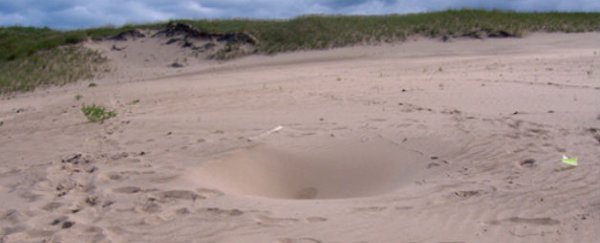For months, geologists were stumped as to how a six-year-old boy named Nathan could completely vanish into the depths of the Mount Baldy sand dune. It defied the laws of physics, they said. But now, the mystery of this towering enigma is beginning to unfurl.
At 37 metres tall, Mount Baldy is the tallest sand dune on the southern shore of Lake Michigan, and until recently, the most popular attraction in the Indiana Dunes National Lakeshore national park. It's thought to be about 4,500 years old, and formed as the water level in Lake Michigan - itself a vast monster, covering an area of 58,000 km squared - dropped to lay bare an expanse of sand that was now free to move and stack as the relentless winds dictated.
While many of the dunes surrounding Lake Michigan are anchored down by trees and shrubbery, it's said that a severe storm rid Mount Baldy of its ties and rendered it a 'wandering', or 'living' dune, able to shift its mass in ways that scientists don't yet fully understand.
"He's here. He's right here," the boy's father was saying, Erin Argyilan, a geologist from the Indiana University Northwest, told Ariel Sabar at the Smithsonian Magazine. Argyilan was performing routine measurements on the dune at the time, and rushed over to help. While it's unclear whether Nathan actually fell through a hole or dug one himself - which ended up connecting to a much larger hole within - all that was left of him when Argyilan arrived was a hole, about 30 cm in diameter. Nathan's voice called out from the darkness telling his parents he was scared, but there was no way anyone could see him.
His unconscious body was retrieved from the depths of the dune 3.5 hours later, and Argyilan was flabbergasted. Dunes aren't supposed to contain holes like this, according to science. "We're seeing what appears to be a new geological phenomenon," she told Angie Leventis Lourgos at The Washington Post earlier this year.
"For sand to accumulate in a way that would leave holes or caverns in the subsurface doesn't at first glance make a whole lot of sense," Alan Arbogast, a Michigan State University geographer and leading expert on the Michigan dunes told Sabar at the Smithsonian Magazine. Another expert told him that dunes only swallow people in Lawrence of Arabia, and even in that outlandish scenario, the dune was covered in quicksand, which is another beast entirely to what was heaped up on the Indiana lakeside.
Back in 2007, Argyilan's colleague Zoran Kilibarda had taken scores of measurements across Mount Baldy and compared these to several aerial photographs to discover that the entire dune had shifted 134 metres away from the lakefront between 1938 and 2007, swallowing up long-forgotten trees, trails and stairs along the way.
Four years later, it was revealed that the dune was flattening out, and the sand that facilitated its movement was coming from inside its inland slope - the area that was open to the public. The slope that swallowed Nathan. Essentially, says Sabar, a void had been opening up inside Mount Baldy.
"The age of the materials and the wet conditions during the spring of 2013 may have forced these materials to become unstable, collapsing and creating openings to the surface," the National Parks Service announced in a press release earlier this year.
Trying to dig Nathan out did no good - fresh sand would just take the place of anything that was pushed away. It took 3.5 hours of excavation, with robotic probes and giant digging vehicles, to get him out. About 2.5 metres down, Sabar says the rescue team started seeing "pipe-like cylinders" - great, winding holes that filled up with sand as quickly as they were uncovered.
Eventually though, through brute machine force, Nathan was uncovered just after 8pm that night, huddled unconscious in one of the winding holes. Somehow, he'd end up surviving the ordeal, and two weeks later, walked out of the hospital. Sabar reports that the doctors suspect either an air pocket in the sand hole saved him, or perhaps his body had reacted to the lack of oxygen by drastically slowing down the operation of his vital organs.
Head to Sabar's article at the Smithsonian to find out more about Argyilan's ongoing investigation into the shifting voids inside Mount Baldy - the "man-eating" sand dune. It's now been closed off to the public indefinitely, to allow her to crack the mystery, and prevent similar things from happening on wandering dunes elsewhere in the world.
Sources: Smithsonian Magazine, The Washington Post
